Nature-based early learning and childcare - influence on children's health, wellbeing and development: literature review
This review of global evidence aimed to understand the extent to which nature-based early learning and childcare (ELC) influences young children’s physical, cognitive, and social and emotional development
Results
Results of the literature search
The results of the systematic literature search are summarised in Figure 1. In total,
the search yielded 40,348 records, of which, 9,250 duplicates were removed.
Of the remaining 31,098 articles, 29,729 irrelevant titles and abstracts were removed leaving 1,370 full text articles to be screened. 1,224 irrelevant articles were excluded (reasons detailed in Figure 1). Two potentially eligible papers were excluded because they could not be adequately translated (28, 29). 70 qualitative studies with no comparator (i.e. exposure, control group, pre/post) were excluded as were a further 11 after having their quality assessed. This left a total of 59 unique studies (representing 65 individual papers), of which 49 were included in the narrative synthesis (quantitative) and 9 were included in the thematic analysis (qualitative) and one study was included in both.
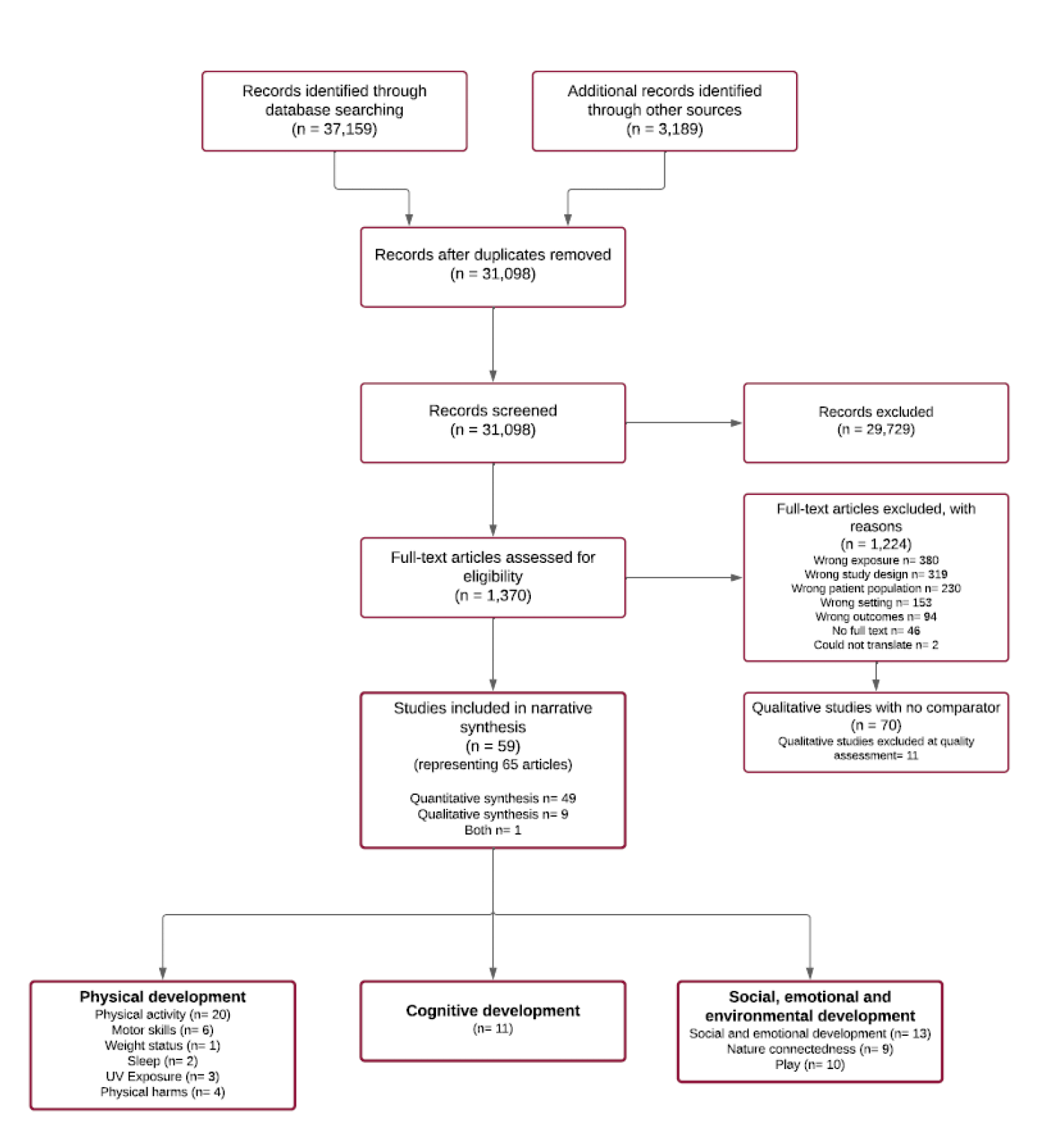
Figure 2 presents the year of publication for the 59 unique studies. Few studies were published between 1998-2012. Since 2013, there has been an increase in publications on this topic.
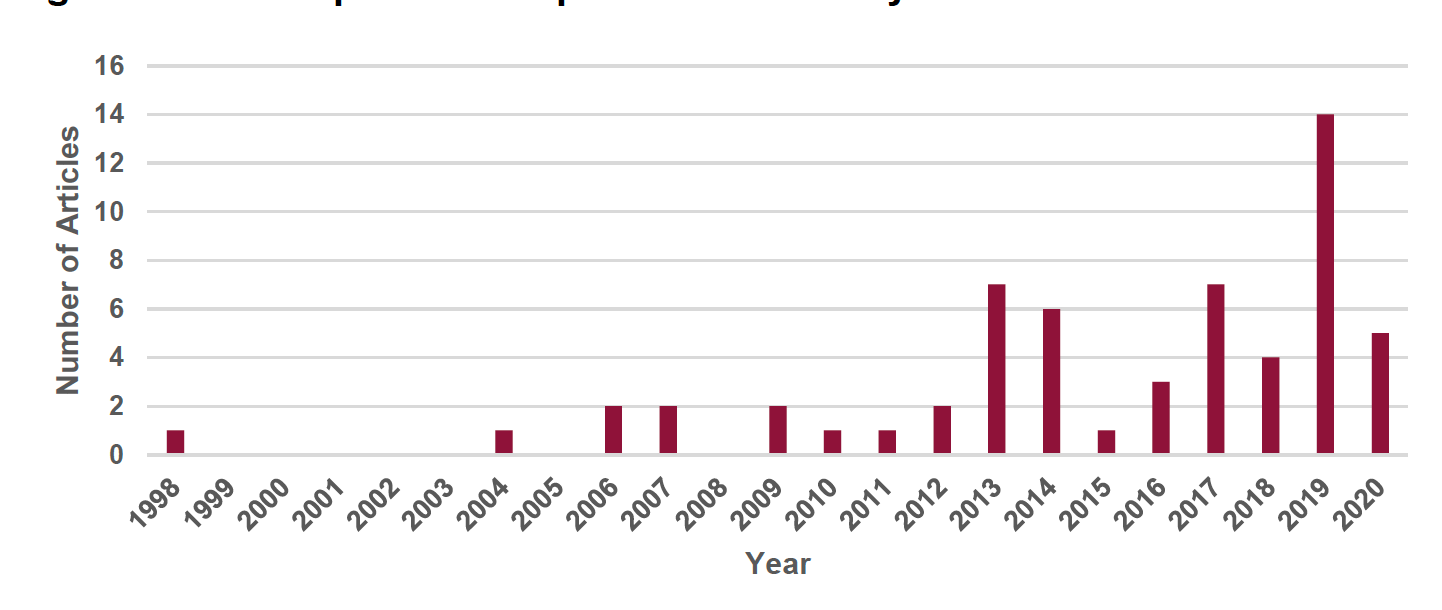
Characteristics of the eligible studies
Geographical location
Most of the studies were published in the USA (n=13), Australia (n=9) and Norway (n= 8). Only 3 studies were published in the UK, of which one study included data from Scotland. Figure 3 presents the number of studies included from each country.
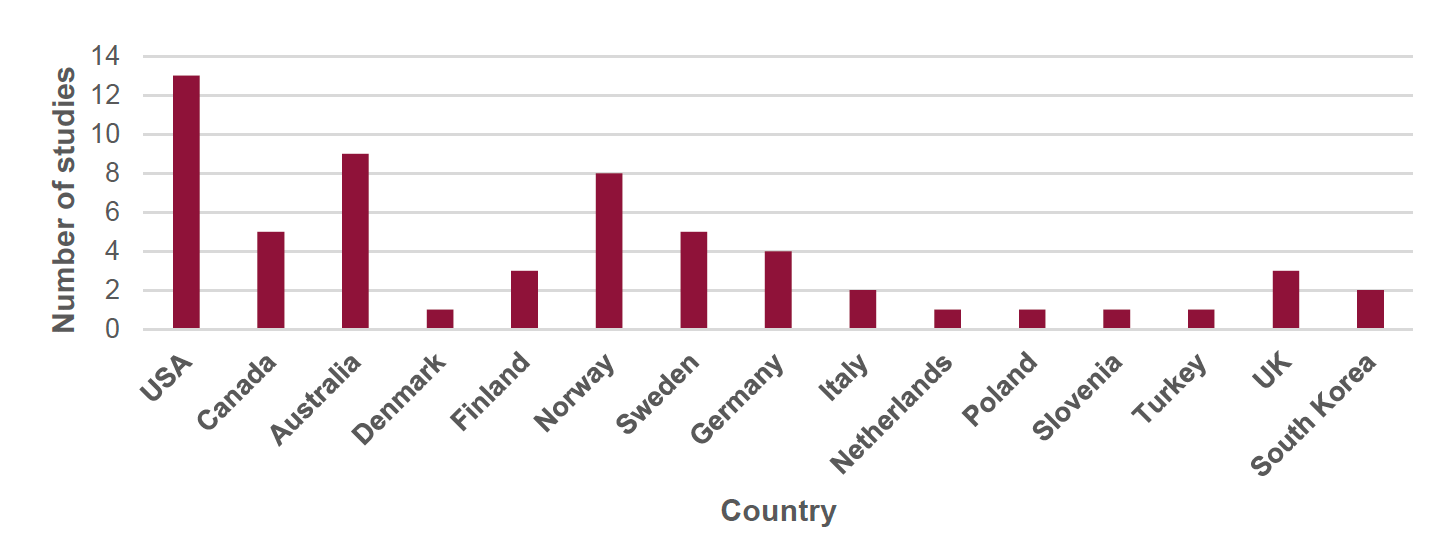
Study designs
Of the quantitative studies, the majority were cross-sectional (n= 22) and controlled cross-sectional (n= 13). Fewer were uncontrolled before and after (n= 6) and controlled before and after (n= 9). Of the cross-sectional studies, one was a mixed-methods and included in both the quantitative narrative synthesis (n=50 unique studies) and the qualitative thematic analysis.
Exposure – Nature
Studies were categorised into four main exposures: nature-based ELC (29 studies), naturalised playgrounds (13 studies), types of nature elements (15 studies) and garden-based interventions (2 studies). Table 1 presents an overview of these categories and their features.
Table 1. Overview of the exposure categories
Nature-based ELC
The ELC curriculum and environment have a strong emphasis on nature where children spend most of their time outdoors in naturalised areas such as woods, forest and/ or naturalised playgrounds. Educators are usually present and may lead on structured educational activities.
Naturalised playgrounds
Interventions which have enhanced the nature in the playground or studies which compare natural playgrounds to traditional playgrounds. Children would not typically spend as much time outdoors in these studies.
Types of natural elements
Studies which looked at the impact of specific natural elements, such as trees, vegetation, hills, grass etc., or specific features or quality of the playground. These studies tended to be controlled cross-sectional or cross-sectional in design.
Garden-based interventions
Studies which include an intervention predicated by a garden component within the ELC setting.
Exposure – Comparison
When studies included a comparison exposure (controlled before and after and controlled cross-sectional study designs only), it tended to be traditional ELC where children would spend less time outdoors and the outdoor playground environment included predominately manmade structures (slide, climbing frame, swings). In some instances, the comparison group may have included some nature through teacher-led eco interventions, or the playground may have included some nature (limited grass and trees). However, the comparison exposure was less than the experimental group.
Sample size and participant characteristics
For sample size and participant characteristics of each study, see Appendix C. Total sample size of the eligible quantitative and qualitative studies was 10,067. Sample sizes were generally small, the majority of controlled and uncontrolled before and after studies had fewer than 100 participants. Controlled cross-sectional and cross-sectional studies also tended to have small sample sizes, but there was a much larger range with one study including 1700 children (experimental n= 506; control n= 1201) (30) and another had less than 20 children (31). Sample size in the qualitative studies ranged from 75 (32) to 12 (33).
As per inclusion criteria, mean age of participants was always 2-7 years. One study assessed girls only (34), all other studies included both genders. Socioeconomic status (SES) was infrequently reported in the eligible studies, in instances when it was reported, SES was generally moderate to high (35-41).
Quality of included studies
Only four studies were of moderate quality (2= nature-based ELC settings, 1= naturalised playgrounds, 1= Types of natural elements) (36, 42-44) and the remaining were rated weak. Figure 4 presents the quality across all studies by assessment item. Studies were generally given a poor rating because participants were unlikely to be representative (selection bias), it was unclear whether the researchers or outcome assessors were aware of the research questions (blinding) and withdrawals and dropouts were not reported or was high (in before and after studies only). Study designs were also rated weak because most were controlled cross-sectional and cross-sectional studies. A weak rating is given to these types of studies because outcomes are assessed at a single timepoint only and so permits drawing conclusions about the causal link between nature exposures in ELC and health and wellbeing outcomes in children. Given the large amount of weak studies, it is important to interpret study findings with caution because it is difficult to know for certain if any possible benefits are as a result of attending nature-based ELC and not any other influencing factor.
See Appendix D for the quality of each quantitative study as assessed by the EPHPP tool.
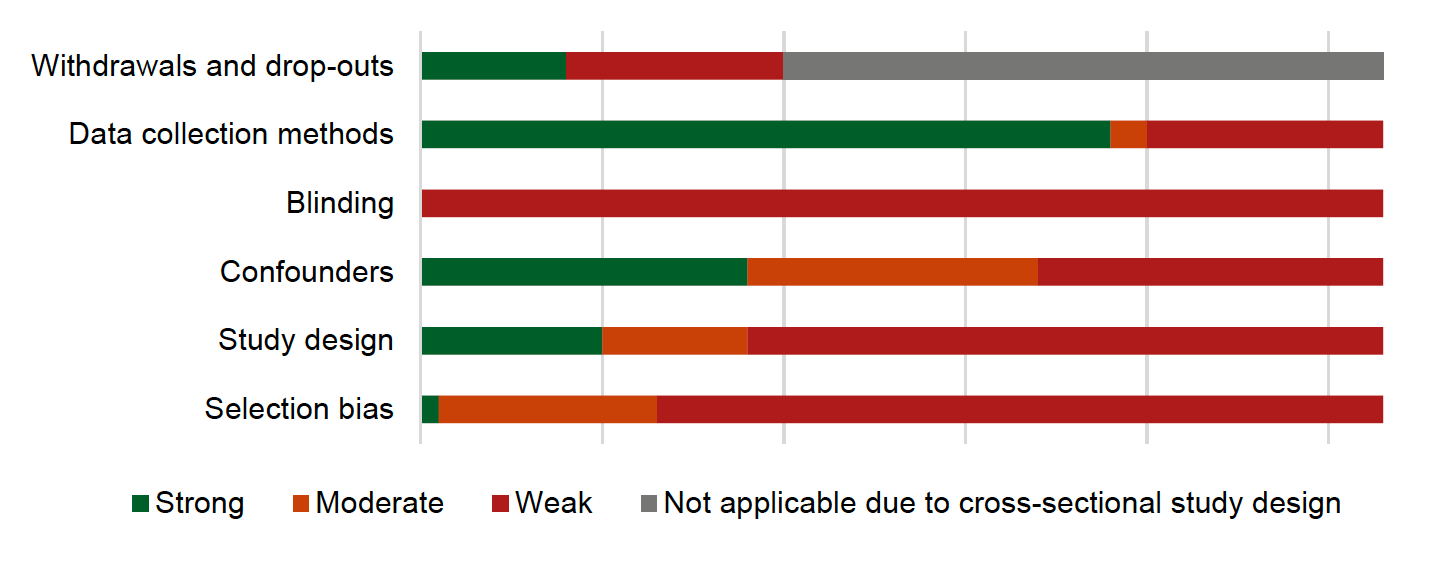
Main findings – Quantitative
Outcomes reported in eligible studies were grouped into three domains: physical development, cognitive development, and social, emotional and environmental development. Of these three higher level categories, we derived 9 sub-domains. Table 3 presents an overview of these (sub)domains and number of studies reporting on each outcome.
| Physical development | Cognitive development | Social, emotional and environmental development |
|---|---|---|
| Physical activity (20) | Cognition and learning (11) | Social and emotional development (13) |
| Motor skills (6) | Nature connectedness (9) | |
| Weight status (1) | Play (10) | |
| Sleep (2) | ||
| UV exposure (3) | ||
| Physical harms (4) |
Before presenting findings for each outcome domain, a combined summary of the evidence will be presented first. Table 4 presents findings where outcomes were reported in more than one study for nature-based ELC. Similarly, Table 5 presents findings where outcomes were reported in more than one study for Types of Natural Elements. These tables report the certainty of evidence for each outcome, the number of studies grouped for each outcome and how many studies favoured the comparison and how many favoured nature. One colour block equates to one study (*unless the study favours neither nature or the comparison), dark green highlights the study favours nature and statistical significance (p<.05); light green favours nature, but no statistical significance; light red/pink favours comparison no statistical significance; and dark red favours comparison and statistical significance (p<.05).
| Outcome | N of studies | Certainty of evidence | Favours comparison | Favours nature | ||||||||
|---|---|---|---|---|---|---|---|---|---|---|---|---|
| Physical | ||||||||||||
| Sedentary time (mins/ ELC day | 2 | Moderate | O | G | ||||||||
| MVPA (mins/ ELC day) | 2 | Moderate | O | G | ||||||||
| Balance | 3 | Moderate | O | DG | DG | |||||||
| Object Control | 2 | Moderate | O | G | ||||||||
| Speed and agility | 3 | Moderate | R | R | O | |||||||
| Illness | 2 | Very low | O | G | ||||||||
| Cognitive | ||||||||||||
| Attention | 3 | Moderate | O | G | G | |||||||
| Self-regulation / control | 3 | Low | G | DG | DG | |||||||
| Social, emotional and cognitive | ||||||||||||
| Social skills | 3 | Moderate | O | G | DG | |||||||
| Social and emotional development | 3 | Moderate | O | G | G | |||||||
| Attachment | 2 | Low | O | G | ||||||||
| Initiative | 2 | Low | O | DG | ||||||||
| Behavioural Problems | 3 | Moderate | R | O | G | |||||||
| Nature Relatedness / biophilia | 6* | Moderate | G | DG | DG | DG | DG | |||||
| Environmentally responsible behaviour | 3 | Moderate | O | O | DG | |||||||
| Awareness of nature | 2 | Low | G | G | ||||||||
| Play interaction | 3 | Moderate | O | DG | DG | |||||||
| Play disruption | 2 | Moderate | R | DG | ||||||||
| Play disconnection | 2 | Moderate | R | DG | ||||||||
Abbreviations: E= experimental; C= comparison; N= number; MVPA= moderate-to-vigorous physical activity; ELC= Early learning and childcare.
One colour block = one study.
* denotes where a study favours neither nature or comparison and is therefore not counted.
■ (dark green – DG) = favours nature and statistical significance (p<.05); ■ (green – G) = favours nature; ■ (orange – O) = favours comparison; ■ (red – R) = favours comparison and statistical significance (p<.05).
| Outcome | N of studies | Certainty of evidence | Favours comparison | Favours nature | ||||||||
|---|---|---|---|---|---|---|---|---|---|---|---|---|
| Physical | ||||||||||||
| Sedentary time (mins/ ELC day | 2 | Very low | O | DG | ||||||||
| MVPA (mins/ ELC day) | 4* | Moderate | O | G | G | |||||||
| Total PA (mins/ ELC day) | 4* | Moderate | G | G | G | |||||||
| Step counts/ ELC day | 2 | Very low | G | DG | ||||||||
Abbreviations: E= experimental; C= comparison; N= number; MVPA= moderate-to-vigorous physical activity; PA= physical activity ELC= Early learning and childcare.
One colour block = one study.
* denotes where a study favours neither nature or comparison and is therefore not counted.
■ (dark green – DG) = favours nature and statistical significance (p<.05); ■ (green – G) = favours nature; ■ (orange – O) = favours comparison.
The quantitative element of the review reported generally favourable findings on the role of nature-based ELC on children's physical, cognitive, social, emotional and environmental development compared with traditional ELC. The findings reported are dived into 3 categories:
i) likely positive association – positive health outcomes with most studies associated with nature-based ELC;
ii) likely negative association – negative health outcome with most studies associated with nature-based ELC; and
iii) inconsistent – unclear whether these studies favoured nature-based ELC or traditional ELC (i.e. not enough evidence).
The evidence suggested that there were no harms associated with attending nature-based ELC.
Based on very low and moderate evidence, playgrounds which included grassed areas, vegetation, natural elements, rocks, hills or shaded areas were positively associated with increased total physical activity, moderate-to-vigorous physical activity (MVPA) and step counts and decreased sedentary time during ELC.
Based on low and moderate evidence, compared to traditional ELC, nature-based ELC was positively associated with:
- balance
- self-regulation (ability to understand and manage behaviour)
- nature relatedness (or biophilia)
- play interactions
Based on moderate evidence, compared to traditional ELC, nature-based ELC was negatively associated with children's speed and agility.
Based on very low, low and moderate evidence, compared to traditional ELC, nature-based ELC had inconsistent findings on the following outcomes:
- object control skills
- attention
- social skills
- social and emotional development
- attachment
- initiative
- awareness of nature
- environmentally responsible behaviour
- illnesses
- behavioural problems (such as temper tantrums or hyperactivity)
- play disruption (aggressive and antisocial behaviours in play) and disconnection (withdrawn behaviour and nonparticipation in play)
Further analysis of the finding for each outcome domain will now be presented.
Outcome Domain 1 - Physical development
The physical development domain presents six related sub-domains: physical activity, motor competence, weight status, sleep, UV exposure and physical harms.
1. Physical Activity
Of the 20 articles reporting on physical activity, 15 studies used device-measured methods to record children's physical activity levels and sedentary time. The ActiGraph accelerometer was used in 12 studies (31, 39-42, 44-49), pedometers were used in two (50, 51) and Global Positioning System (GPS) devices were used once (52). The remaining 5 eligible studies used direct observational methods such as the Observational System for Recording Physical Activity in Children-Preschool (OSRAC-P) or Children's Activity Rating Scale (CARS) which codes varying physical activity intensities (38, 53-56) (see Appendix E). The methodological quality across the 20 studies that assessed physical activity is shown in Figure 5.
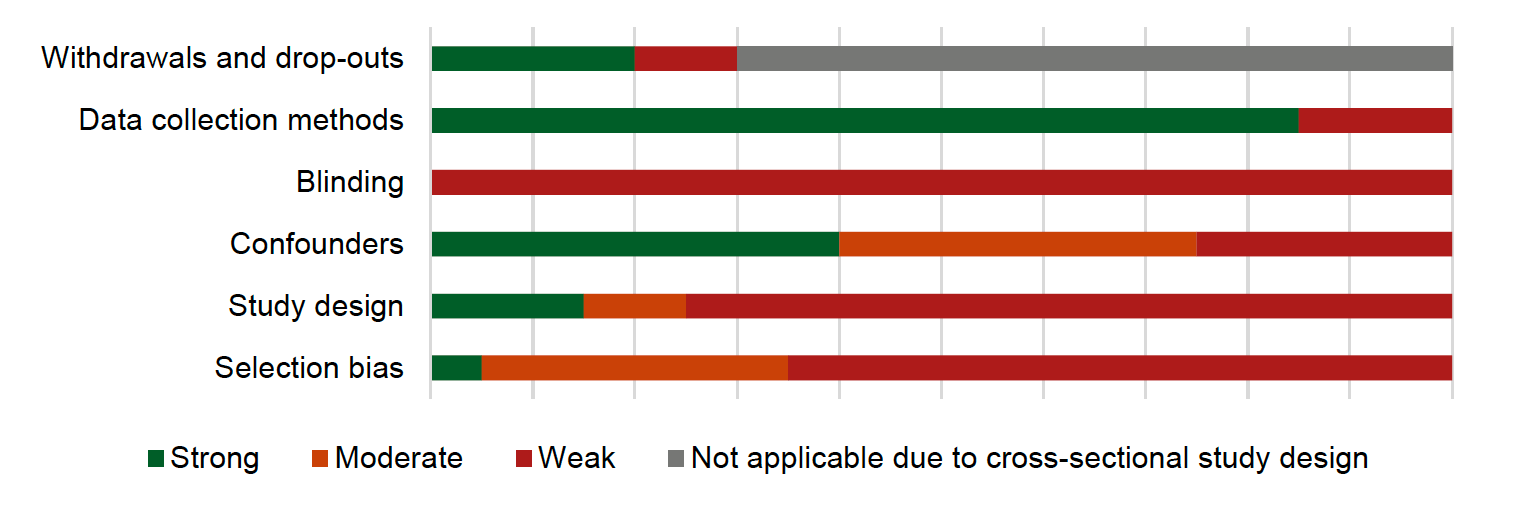
1.1. Nature-based ELC settings
Table 5 presents the results from device-measured sedentary time (mins/ ELC day) and MVPA (mins/ ELC day) in eligible studies where these outcomes were reported in more than one study. Findings indicated that there was a positive health impact on sedentary time (mins/ ELC day) between children attending nature-based ELC and children attending traditional ELC (45), the other study demonstrated a negative health impact (46). Similarly, there were conflicting findings for time spent in MVPA (mins/ ELC day) with one study reporting 6 minutes more MVPA (mins/ ELC day) in children who attended nature-based ELC (45) and the other showing 15.5 minutes less MVPA (mins/ ELC day) compared to children attending a typical ELC (46).
| Study ID | Study Design | Sample size (E/C) | Favours comparison | Favours nature | ||||||
|---|---|---|---|---|---|---|---|---|---|---|
| Nature-based ELC | ||||||||||
| Sedentary time (mins/ ELC day) | ||||||||||
| Müller et al (2017)(45) | Controlled before & after | 43 / 45 | G | |||||||
| Fyfe-Johnson et al (2019)(46) | Controlled cross-sectional | 20 / 13 | O | |||||||
| MVPA (mins/ ELC day) | ||||||||||
| Müller et al (2017)(45) | Controlled before & after | 43 / 45 | G | |||||||
| Fyfe-Johnson et al (2019)(46) | Controlled cross-sectional | 20 / 13 | O | |||||||
| Types of Natural Elements | ||||||||||
| Sedentary time (mins/ ELC day) | ||||||||||
| Määttä et al (2019b)(41) | Cross-sectional | 655 | DG | |||||||
| Sugiyama et al (2012)(49) | Cross-sectional | 89 | O | |||||||
| MVPA (mins/ ELC day) | ||||||||||
| Ng et al (2020)(44) | Controlled before & after | 159 / 138 | / | / | ||||||
| Christian et al (2019)(39) | Cross-sectional | 678 | G | |||||||
| deWeger (2017)(47) | Cross-sectional | 274 | G | |||||||
| Sugiyama et al (2012)(49) | Cross-sectional | 89 | O | |||||||
| Total PA (mins/ ELC day) | ||||||||||
| Ng et al (2020)(44) | Controlled before & after | 159 / 138 | / | / | ||||||
| Christian et al (2019)(39) | Cross-sectional | 678 | G | |||||||
| deWeger (2017)(47) | Cross-sectional | 274 | G | |||||||
| Määttä et al (2019)(40) | Cross-sectional | 864 | G | |||||||
| Step counts/ ELC day | ||||||||||
| Boldemann et al (2006)(50) | Cross-sectional | 199 | DG | |||||||
| deWeger (2017)(47) | Cross-sectional | 274 | G | |||||||
Abbreviations: E= experimental; C= comparison; N= number; MVPA= moderate-to-vigorous physical activity; PA= physical activity; ELC= Early learning and childcare.
One colour block = one study.
■ (dark green – DG) = favours nature and statistical significance (p<.05); ■ (green – G) = favours nature; ■ (orange – O) = favours comparison; ■ (grey – //) = favours neither nature or control, or statistics not presented.
Controlled before & after studies – difference between experimental and control group at follow-up (unless stated). Uncontrolled before & after studies – change since baseline (unless stated). Controlled cross sectional – difference between experimental and control (unless stated). Cross-sectional – positive, negative or no association.
For outcomes that could not be grouped together in the effect direction plot, findings of one weak study suggested children who attended nature ELC engaged in less habitual (mins/day) light physical activity and MVPA and more sedentary time compared to the control across the full week, weekday and weekend (46). The two studies using direct observational methods to assess physical activity in nature ELC found that children in the nature kindergarten were less stationary and engaged in more slow-easy and moderate physical activity compared to the control (38, 53).
1.2. Naturalised playgrounds
Studies for this exposure could not be grouped together because a single outcome was not reported in more than one study. Findings of one intervention study where the playground was enhanced to include more natural elements indicated a positive impact on MVPA and a statistically significant impact on PA and non-sedentary PA assessed using direct observation (54). In another intervention study, device measured MVPA significantly decreased from baseline to follow-up by 1.32 minutes (42). The other three cross-sectional studies found CPM (a measure of total PA) were similar across a natural and traditional playgrounds (31) and gait/cycles (similar to step counts) were lower in a nature playground (51), but children covered a greater distance (km) (52).
1.3. Types of natural elements
Table 5 presents the results from device-measured sedentary time (mins/ ELC day), MVPA (mins/ ELC day), total physical activity (mins/ ELC day) and step counts (ELC day) in eligible studies where these outcomes were reported in more than one study. Four studies looked at device measured MVPA (mins/ ELC day), of which one study reported non-significant difference for natural elements between the experimental and control groups (44), two studies favoured nature (39, 47) and one study showed no association (49). Grassed areas were positively and significantly associated with MVPA (44). Higher vegetation (height in metres) (39), natural elements (47), gradient and shade had a positive, but non-significant, association with MVPA (49). In another study, natural surfaces were found to be significantly associated with less MVPA, and vegetation did not have a favourable association with MVPA (49).
In the four studies that looked at total device measured physical activity (mins/ ELC day), three favoured the respective types of natural elements and one study reported non-significant differences for natural elements between the experimental and control groups (44). Grassed areas were positively and significantly associated with total physical activity (44). Vegetation, natural elements, grass, and rocks had a positive association with total PA, but these were non-significant (39, 40, 47). Forest and trees were negatively associated with total physical activity (mins/ ELC day) (40).
Higher frequency of nature trips was significantly associated with lower levels of sedentary time (mins/ ELC day) (41). Similarly, gradient (such as hills) and shade showed an association with lower levels of sedentary time (mins/ outdoor time), but "mostly natural surfaces" and vegetation were associated with increased sedentary time (all non-significant) (49).
Step counts were found to be significantly associated with high environment score (playgrounds which had a large outdoor area, trees and shrubbery, and integrated play areas with vegetation) (50) and natural elements (47).
Additional findings (not presented in Table 5), indicated that natural elements were significantly and positively associated with a reduction in percent time spent in habitual sedentary time, and increased MVPA and CPM (57). Vegetation and hilly landscape were significantly associated with a reduced percent time in MVPA (ELC day) (48). Hilly landscape was also associated with reduced percent time in MVPA, but this was non-significant (48). There was a positive, but non-significant association with nature and PA assessed using direct observation (55) . Finally, there was no association between nature and observations of high wellbeing and PA assessed using direct observation (56).
Full results for physical activity can be found in Appendix E.
2. Motor competence
Motor competence refers to the child's ability to perform a range of movement skills, such as running, jumping, catching and throwing. These are important as they enable children to engage in physical activity throughout their life course. Six studies assessed outcomes related to motor competence and all examined the effect or association of nature-based ELC on outcomes related to children's motor competence (18, 45, 58-63). Figure 6 presents the quality of studies assessing motor competence by assessment item for methodological quality.

2.1. Nature-based ELC Settings
Studies explored a range of outcomes related to motor competence. Three studies assessed a range of motor or fundamental movement skills, such as jumping, running, balance and strength (18, 59-62). Motor competence was reported more broadly in three studies (45, 58, 61). Practitioner perspectives of children's physical development was reported in one study (63).
Table 6 presents the results from motor competence (balance, object control skills, and speed and agility) in eligible studies where these outcomes were reported in more than one study. Findings suggested that in two studies, balance was significantly better in children who attended nature ELC compared to children who attended traditional settings (18, 59, 60, 62). Whereas, one study found that children who attended traditional settings performed better (61). There were mixed findings for object control skills (catching, throwing, dribbling) (45, 61) and children in nature ELC performed worse in the shuttle run test (test of speed and agility) in all three studies (two significant, one non-significant) (18, 59-62).
Additional findings reported that body function, gross motor skills and fine motor skills were better in children who attended nature ELC compared to the control, but these differences were non-significant (58). Similarly, locomotor skills (running, skipping, hopping) were significantly better in nature ELC compared to traditional ELC (45). However, how children perceive their own motor competence was marginally lower in children who attended nature ELC compared to the comparison (45). One study indicated that total motor competence (manual dexterity, ball skills and balance) was worse in children who attended nature ELC compared to children who attended traditional ELC (61), but this difference was not statistically significant.
Children who attended nature ELC also performed better across a number of skills. At follow-up, children performed significantly better at skipping compared to children who attended a traditional setting (18, 59, 60). In another study, children from nature ELC performed significantly better at hanging on a pull up bar (strength), jumping left/right and one-leg jump (left foot only) compared to urban and rural children who attended traditional ELC (62). However, total motor fitness scores were found to be significantly lower in children who attended nature ELC compared to control schools (61).
Full results for motor competence can be found in Appendix E.
3. Weight status
Weight status was assessed in only one cross-sectional study which compared BMI and waist circumference in children from schools with high environment quality (i.e. large space, vegetation, tress etc.) compared to low environment quality (64). Figure 7 presents the quality of the study assessing weight status by assessment item for methodological quality.
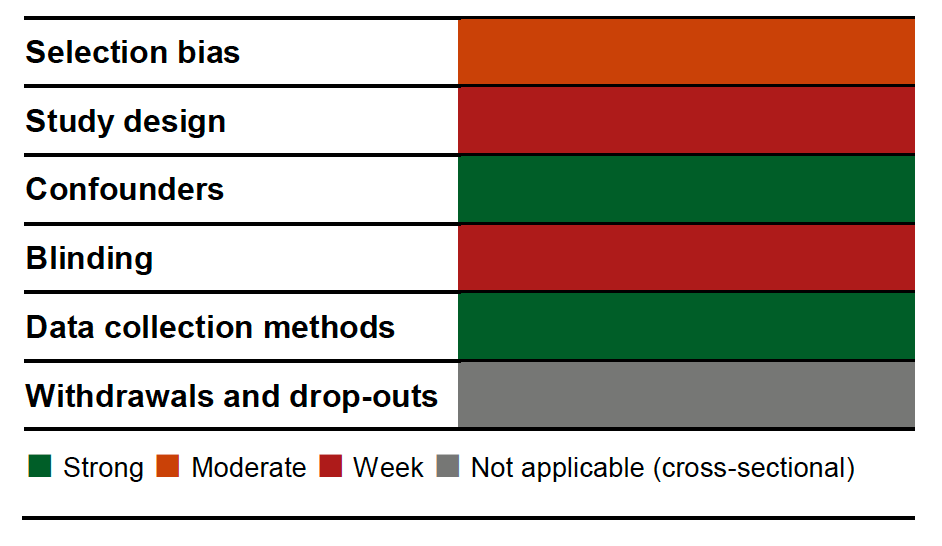
3.1. Types of natural elements
Findings from this study suggested that outdoor environment quality was not significantly associated with BMI or waist circumference (64). However, prevalence of overweight and waist circumference were lower in the higher environment quality group compared to the lower quality (64).
4. Sleep
Sleep was assessed in two studies, of which one was a controlled before and after which compared sleep time and quality in children from a nature-based ELC compared to a traditional ELC (36). The other study was cross-sectional and compared sleep duration in high quality versus low quality outdoor environments (64). These studies could not be combined and presented in a summary table because the exposures and study designs were different. Figure 8 presents the quality of studies assessing sleep by assessment item for methodological quality.
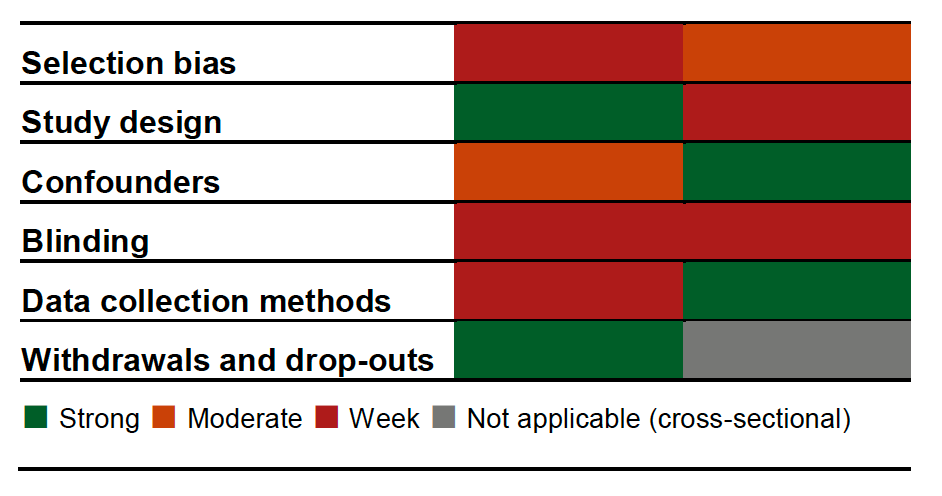
4.1. Nature-based ELC Settings
In the controlled before and after study, sleep was assessed using the Children's Sleep Habits Questionnaire (CSHQ) which assesses eight sleep domains: bedtime resistance, sleep onset delay, sleep duration, sleep anxiety, night wakings, parasomnia, sleep-disordered breathing, and daytime sleepiness (36). Total sleep time was also reported. Findings indicated that Total CSHQ score, sleep disordered breathing and daytime sleepiness was significantly better in the children who attended nature-based ELC compared to traditional. All other domains were better but statistically non-significant. Total sleep time was also higher in children who attended nature-based ELC (10.5 hours ± 1.0 vs 10.4 ± 0.9) (36).
4.2. Types of natural elements
Mean sleep time (minutes) was also reported to be higher in ELC settings which had a higher environment score (658 minutes ± 44) compared to a lower environment score (642 ± 32) and this association was also significant. High environment scores relate to playgrounds which have a large space, trees, vegetation, hilly terrain and integrate natural elements with play structures.
5. UV Exposure
5.1. Types of natural elements.
UV Exposure was assessed in three cross-sectional studies, of which two were conducted in Sweden and one in Australia (39, 50, 65). These studies examined the association between high environmental quality (i.e. large space, vegetation, tress etc.) versus low quality. All three studies found UV exposure was lower and significantly associated with environmental quality (39, 50, 65). UV exposure was lower in areas where vegetation and trees were more integrated into the playground. Figure 9 presents the quality of studies assessing UV exposure by assessment item for methodological quality.
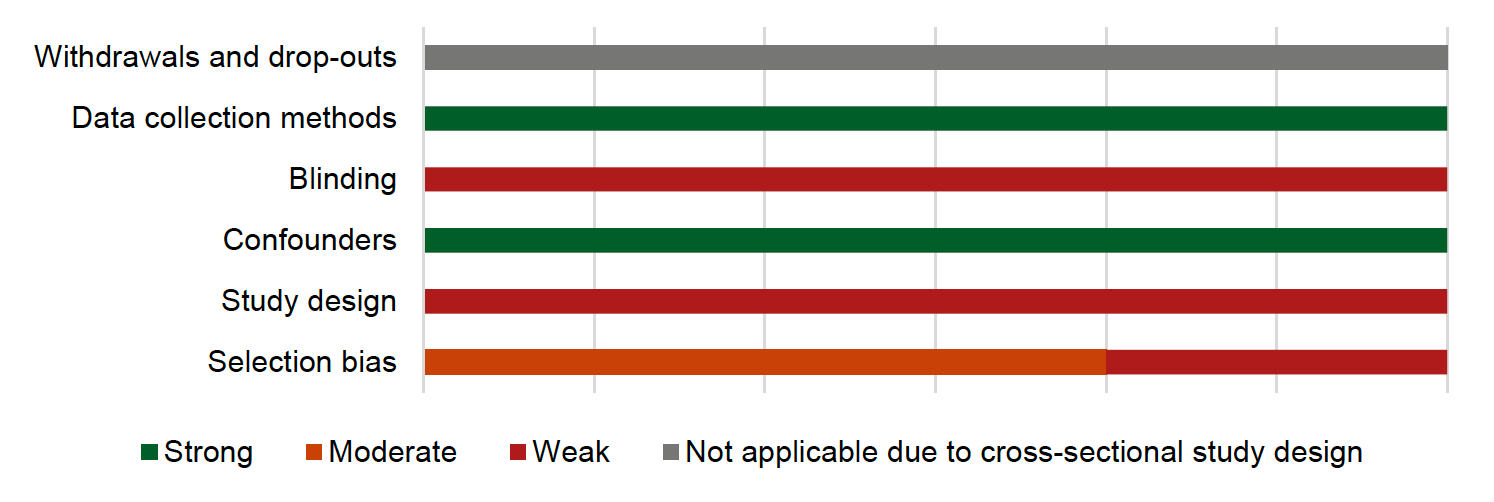
6. Harms
Possible harms and negative consequences of nature-based ELC was assessed in three controlled cross-sectional studies (30, 37, 66), and the association between environment quality was assessed in one cross-sectional study (64). The quality across the four studies reporting harms is shown in Figure 10.
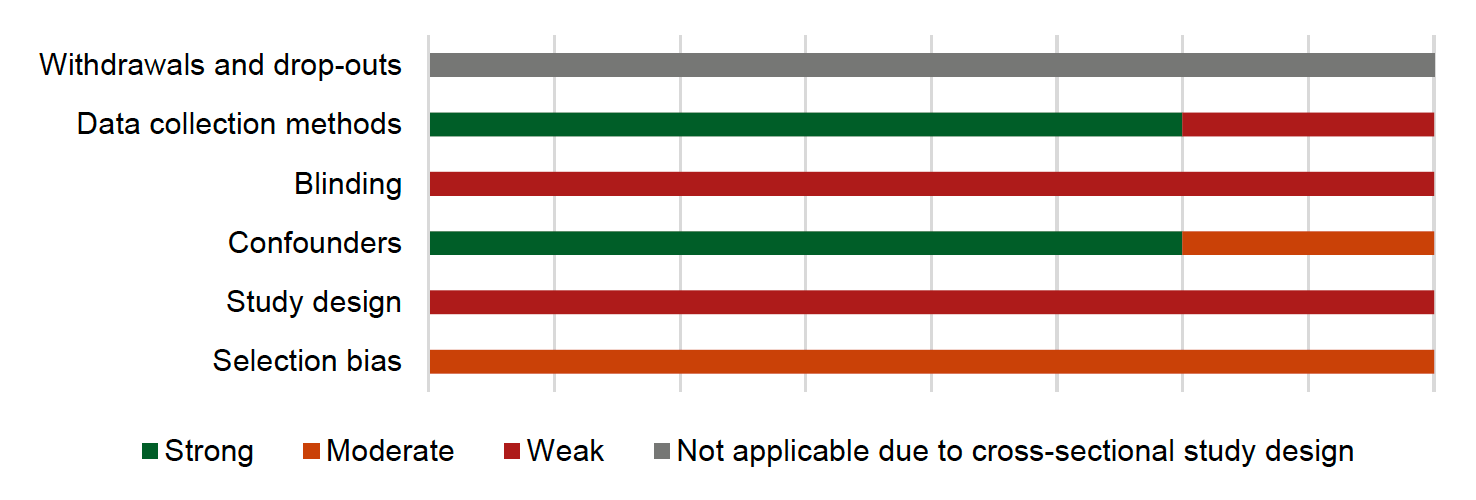
6.1. Nature-based ELC settings
Table 6 presents the results from illness and sickness in eligible studies where these outcomes were reported in more than one study in nature ELC compared to traditional ELC (37, 66). Illnesses and sickness absenteeism were reported as the number of days the child was absent from school as reported by their teacher or parent (37, 66). One study reported fewer illness episodes in the nature-based ELC compared to the traditional ELC (non-significant) (37). The other found that sickness absenteeism was lower in regular ELC compared to nature-based ELC, but again this was non-significant (66).
Total minor injuries (wound/cut, sprain, bite) were also explored, and differences were found between genders. Boys in nature ELC had less (non-significant) minor injuries compared to boys who attended traditional ELC (37). Whereas girls who attended nature ELC had significantly higher minor injuries than girls who attended traditional education (37). Tick bites and borreliosis (or Lyme's Disease) were also significantly more prevalent in nature ELC in Germany compared to traditional ELC (30). 73% of children who attended nature-based ELC reported presence of at least one tick bite versus 27% in the control (30). Similarly, 2% of children who attended nature-based ELC reported presence of Lyme Disease versus 0.4% of control children (30). It is likely that children in nature-based ELC spend more time outdoors and so have greater exposure to ticks.
6.2. Types of natural elements
Another study explored the association between illness symptoms (runny nose, cough fever, respiratory problems etc.) and high quality versus low quality environment. There was no association between environment quality and symptoms (64).
| Study ID | Study Design | Sample size (E/C) | Favours comparison | Favours nature | |||||
|---|---|---|---|---|---|---|---|---|---|
| Balance | |||||||||
| Ene-Voiculescu & Ene-Voiculescu (2015)(18, 59, 60) | Controlled before & after | 46 / 29 | DG | ||||||
| Lysklett et al (2019)(61) | Controlled cross sectional | 43 / 49 | O | ||||||
| Scholz & Krombholz (2007)(62) | Controlled cross-sectional | 45 / 84 | DG | ||||||
| Object Control | |||||||||
| Müller et al (2017)(45) | Controlled before & after | 43 / 45 | G | ||||||
| Lysklett et al (2019)(61) | Controlled cross sectional | 43 / 49 | O | ||||||
| Speed and agility | |||||||||
| Ene-Voiculescu & Ene-Voiculescu (2015)(18, 59, 60) | Controlled before & after | 46 / 29 | O | ||||||
| Lysklett et al (2019)(61) | Controlled cross sectional | 43 / 49 | R | ||||||
| Scholz & Krombholz (2007)(62) | Controlled cross-sectional | 45 / 84 | R | ||||||
| Illness | |||||||||
| Frenkel et al (2019)(37) | Controlled cross-sectional | 71 / 70 | G | ||||||
| Moen et al (2007)(66) | Controlled cross-sectional | 267 / 264 | O | ||||||
Abbreviations: E= experimental; C= comparison; N= number; ELC= Early learning and childcare.
One colour block = one study.
■ (dark green – DG) = favours nature and statistical significance (p<.05); ■ (green – G) = favours nature; ■ (orange – O) = favours comparison; ■ (red – R) = favours comparison and statistical significance (p<.05).
Controlled before & after studies – difference between experimental and control group at follow-up (unless stated). Uncontrolled before & after studies – change since baseline (unless stated). Controlled cross sectional – difference between experimental and control (unless stated). Cross-sectional – positive, negative or no association.
Summary of physical domain
In summary, it is unclear whether nature-based ELC have a positive effect on children's sedentary time and moderate-to-vigorous physical activity (MVPA) during the ELC day. However, evidence suggested that specific natural elements: grass, hills, vegetation and rocks had a positive association with ELC day MVPA, total physical activity and reduction in sedentary time, whereas trees may limit physical activity levels. Findings for motor competence were mixed: generally balance was better in children who attended nature ELC, but they performed worse in a test of speed and agility compared to children from traditional ELC. Findings for object control skills and illnesses were inconsistent.
Outcome Domain 2 - Cognitive development
7. Cognition and learning
A total of 11 studies (representing fifteen papers) included a cognitive or learning related outcome. Seven studies looked at the associations of nature ELC (34, 35, 45, 46, 58, 63, 67-71). Only one cross-sectional study had a naturalised playground exposure which compared outdoor green spaces to indoors (72), one study looked at high environment versus low environment (natural elements) (73) and two utilised garden-based interventions (74, 75). The quality across the studies reporting on cognition and learning is shown in Figure 11.
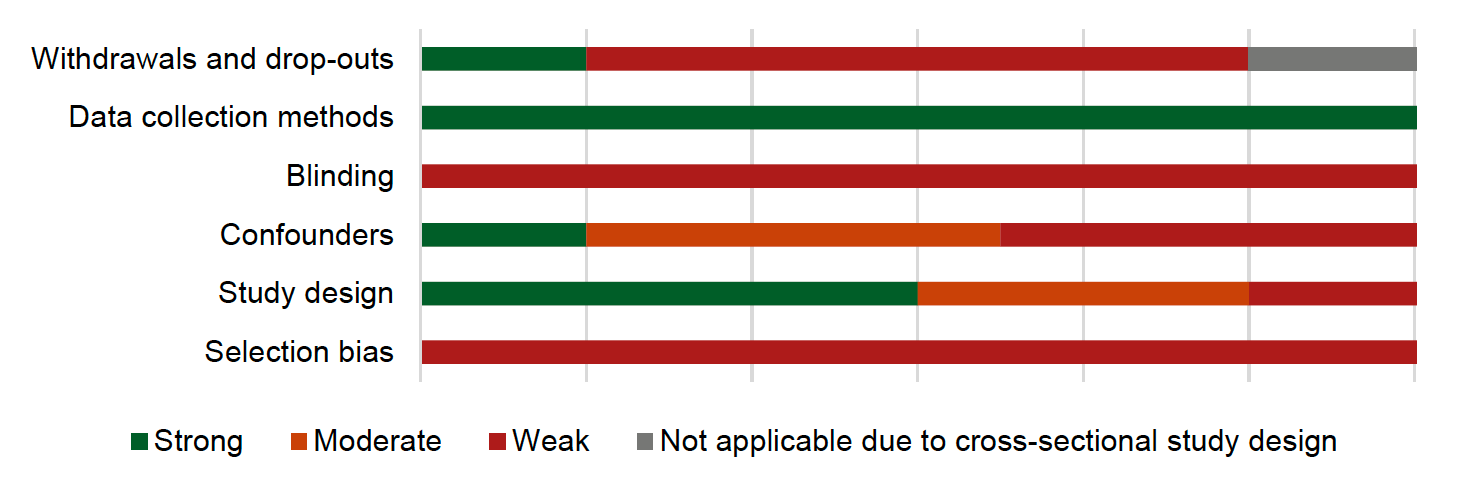
7.1. Nature-based ELC settings
Table 7 presents the results for cognitive development in eligible studies where these outcomes were reported in more than one study. Two studies found a favourable association with children's attention in nature-based ELC compared to traditional ELC (45, 46, 67, 68). There was a positive trend for self-regulation (ability to understand and manage behaviour) across three studies, with two studies reporting significantly higher scores in children who attended nature ELC compared to children who attended traditional settings (35, 45, 67, 70).
| Study ID | Study Design | Sample size (E/C) | Favours comparison | Favours nature | |||||
|---|---|---|---|---|---|---|---|---|---|
| Attention | |||||||||
| Burgess & Ernst (2020)(67, 68) | Controlled before & after | 84 / 24 | G | ||||||
| Müller et al (2017)(45) | Controlled before & after | 43 / 45 | O | ||||||
| Fyfe-Johnson et al (2019)(46) | Controlled cross-sectional | 20 / 13 | G | ||||||
| Self-regulation / control | |||||||||
| Cooper (2018)(35) | Controlled before & after | 13 / 11 | G | ||||||
| Müller et al (2017)(45) | Controlled before & after | 43 / 45 | DG | ||||||
| Ernst et al (2019)(67, 70) | Uncontrolled before & after | 78 | DG | ||||||
Abbreviations: E= experimental; C= comparison; N= number; ELC= Early learning and childcare.
One colour block = one study.
■ (dark green – DG) = favours nature and statistical significance (p<.05); ■ (green – G) = favours nature; ■ (orange – O) = favours comparison
Controlled before & after studies – difference between experimental and control group at follow-up (unless stated). Uncontrolled before & after studies – change since baseline (unless stated). Controlled cross sectional – difference between experimental and control (unless stated). Cross-sectional – positive, negative or no association.
Two of the included studies looked at the association between nature ELC and executive functions of which one examined three domains: working memory, attention (presented above) and inhibition (45) and the other study tested overall executive function (cognitive flexibility, inhibitory control and working memory) (67, 69). Findings indicated there were small improvements in working memory and association with inhibition (45). Overall executive function score was higher in the nature ELC compared to the control, but this was non-significant (67, 69). In another study, cognitive development was lower in nature- based ELC and teacher perception of language development was higher; however, these differences were non-significant (58). There was also no significant differences in the nature ELC compared to the control for communication (35). Total learning behaviours - assessed across three dimensions: attention, competence motivation and attitudes - was measured in another study (67, 68). Children who attended nature ELC had a higher total score compared to traditional ELC, indicating better learning behaviours but this was non-significant. However, kindergarten readiness (counting, rhyming, recognition) was lower in children who attended nature ELC than those who attended a traditional setting (34). There were marginal differences in curiosity scores in children who attended nature ELC compared to the control group (67). Finally, there were significant improvements in areas of creativity (fluency originality and imagination in children who attended nature ELC.
See appendix E for full findings related to the cognitive domain.
7.2. Naturalised playgrounds
The one eligible study utilised a visual spatial task (an indicator of children's direct attention) to determine if there was a difference in children who had been exposed to playground green spaces for free play compared to children who were indoors (72). Findings suggested that children who had been exposed to free play in green space gained higher visual spatial accuracy scores compared to children in the indoors setting (72).
7.3. Types of natural elements
One eligible study looked at attention in relation to ELC which had a high-quality environment (i.e. large space, vegetation, tress etc.) to those which had a low-quality environment (73). Findings indicated that the two domains of attention: hyperactivity and inattention were lower in schools with high quality environments and inattention was significantly associated (73).
7.4. Garden-based interventions
The two eligible garden-based intervention studies assessed varying outcomes. One study looked at scientific attitudes and abilities (74) and the other study assessed delay gratification (self-regulation) and visual motor integration (hand-eye coordination) (75). All subcategories of scientific attitudes and abilities significantly improved from baseline to follow-up (measured one week after a 24 week intervention) (74). Delay gratification (self-regulation) and visual motor integration did not significantly improve from baseline to follow-up (75).
Summary of cognitive domain
Findings indicated that for attention, two studies demonstrated positive health impacts and one study showed a negative health impact. More evidence supported self-regulation (ability to understand and manage behaviour) with three studies demonstrating a positive health impact for children attending nature-based ELC compared to children attending traditional ELC.
Outcome Domain 3 - Social, emotional and environmental development
The social, emotional and environmental development domain presents three related outcomes: social and emotional, nature connectedness and play.
8. Social and emotional outcomes
A total of thirteen studies included an outcome related to social and emotional development, of which four studies were controlled before and after (34, 35, 45, 58), four were uncontrolled before and after (42, 54, 70, 74), one was a controlled cross-sectional (46) and the remaining four were cross-sectional (55, 63, 64, 72). The quality across the thirteen studies reporting on social and emotional outcomes is shown in Figure 12.
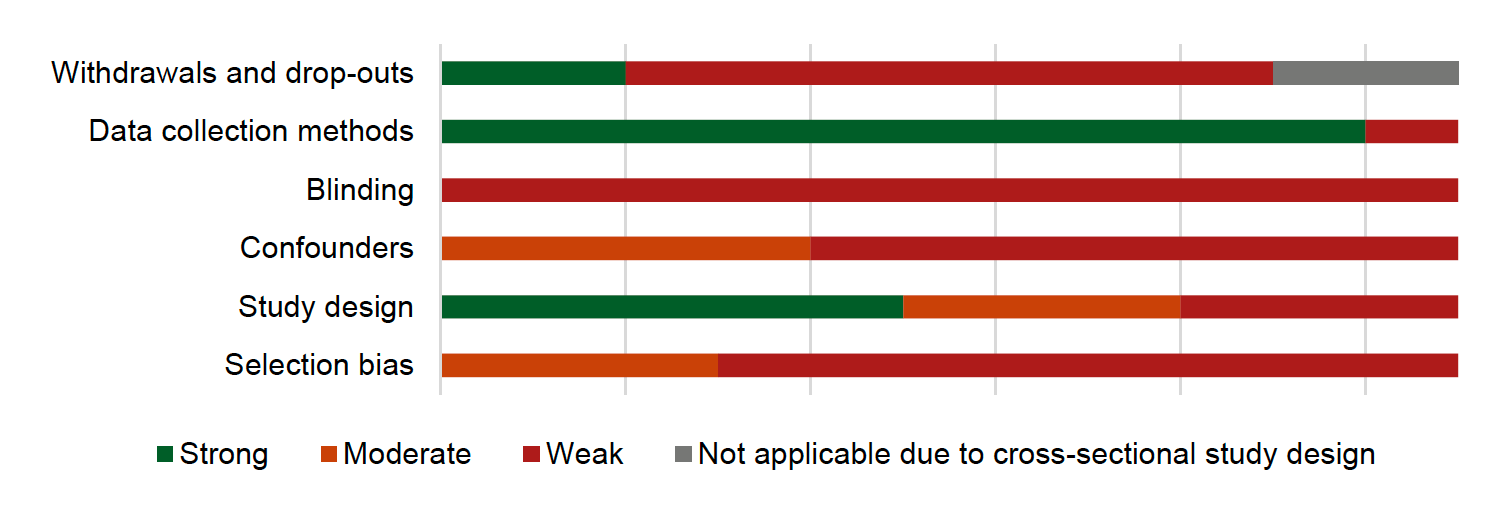
8.1. Nature-based ELC settings
Table 8 presents the results for social and emotional outcomes in eligible studies where these were reported in more than one study. This included social skills, social and emotional development, attachment (child's ability to promote and maintain positive connections with others), initiative (child's ability to use independent thought and action), and behavioural problems. For social skills (including prosocial behaviour, social responsibility), two of the three studies reported higher scores in children who attended nature ELC (34, 45, 46). Similarly, social and emotional development was higher (all non-significant) in children who attended nature ELC compared to traditional ELC in two studies (35, 46, 58). Findings for attachment and initiative were mixed across two studies (35, 67). Children from nature ELC also exhibited higher behavioural problems across two studies (34, 45) and another study suggesting behavioural problems were lower in children who attended nature ELC (46).
In addition, resilience was assessed in one study, which found that total protective factors as reported by the parent and teacher significantly improved from baseline to follow-up (67, 70).
| Study ID | Study Design | Sample size (E/C) | Favours comparison | Favours nature | |||||
|---|---|---|---|---|---|---|---|---|---|
| Social skills | |||||||||
| Cordiano et al (2019)(34) | Controlled before & after | 12 / 14 | O | ||||||
| Müller et al (2017)(45) | Controlled before & after | 43 / 45 | DG | ||||||
| Fyfe-Johnson et al (2019)(46) | Controlled cross-sectional | 20 / 13 | G | ||||||
| Social and emotional development | |||||||||
| Agostini et al (2018)(58) | Controlled before & after | 41 / 52 | G | ||||||
| Cooper (2018)(35) | Controlled before & after | 13 / 11 | O | ||||||
| Fyfe-Johnson et al (2019)(46) | Controlled cross-sectional | 20 / 13 | G | ||||||
| Attachment | |||||||||
| Cooper (2018)(35) | Controlled before & after | 13 / 11 | O | ||||||
| Ernst et al (2019)(67, 70) | Uncontrolled before & after | 78 | G | ||||||
| Initiative | |||||||||
| Cooper (2018)(35) | Controlled before & after | 13 / 11 | O | ||||||
| Ernst et al (2019)(67, 70) | Uncontrolled before & after | 78 | DG | ||||||
| Lower behavioural problems | |||||||||
| Cordiano et al (2019)(34) | Controlled before & after | 12 / 14 | R | ||||||
| Müller et al (2017)(45) | Controlled before & after | 43 / 45 | O | ||||||
| Fyfe-Johnson et al (2019)(46) | Controlled cross-sectional | 20 / 13 | G | ||||||
Abbreviations: E= experimental; C= comparison; N= number; ELC= Early learning and childcare.
One colour block = one study.
■ (dark green – DG) = favours nature and statistical significance (p<.05); ■ (green – G) = favours nature; ■ (orange – O) = favours comparison; ■ (red – R) = favours comparison and statistical significance (p<.05).
Controlled before & after studies – difference between experimental and control group at follow-up (unless stated). Uncontrolled before & after studies – change since baseline (unless stated). Controlled cross sectional – difference between experimental and control (unless stated). Cross-sectional – positive, negative or no association.
8.2. Naturalised playgrounds
Three studies with naturalised playgrounds included outcomes related to children's social and emotional wellbeing. Two studies implemented interventions aimed at enhancing the nature in the playground (42, 54) and the other compared free play in ELC green spaces compared to indoors (72). All studies assessed social skills and interactions, of which one found an improvement from baseline to follow-up and the other found positive associations between social interactions and free play in nature playgrounds (42, 72). However, another study reported significantly more negative teacher and children interactions (54). Children's strengths and difficulties, as measured using the strengths and difficulties questionnaire, improved from baseline to follow-up (42) and stress was lower in free play in nature playgrounds compared to free play indoors (72).
8.3. Types of natural elements
Two studies assessed whether nature was associated with aspects of social and emotional wellbeing. One study assessed whether nature was related to children's emotional wellbeing as assessed by the Leuven Well-being Scale (55). It was found that nature was a statistically significant predictor of emotional wellbeing (55). The other study assessed stress by measuring cortisol levels and found that higher quality environments (i.e. large space, vegetation, tress etc.) increased children's stress levels compared to low quality environments (64).
8.4. Garden-based interventions
This study aimed to determine the effects of a horticulture intervention on emotional intelligence and prosocial behaviour (74). There was a significant and positive effect of the intervention on both of these outcomes from baseline to follow-up (74).
See appendix E for full results on social and emotional wellbeing.
9. Nature connectedness
Nine studies looked at the impact of attending nature ELC on nature connectedness, of which three studies were controlled before and after (43, 45, 58), two were uncontrolled before and after (76, 77), three were controlled cross-sectional (78-80) and one was cross-sectional (63). The quality across the nine studies reporting on nature connectedness outcomes is shown in Figure 13.
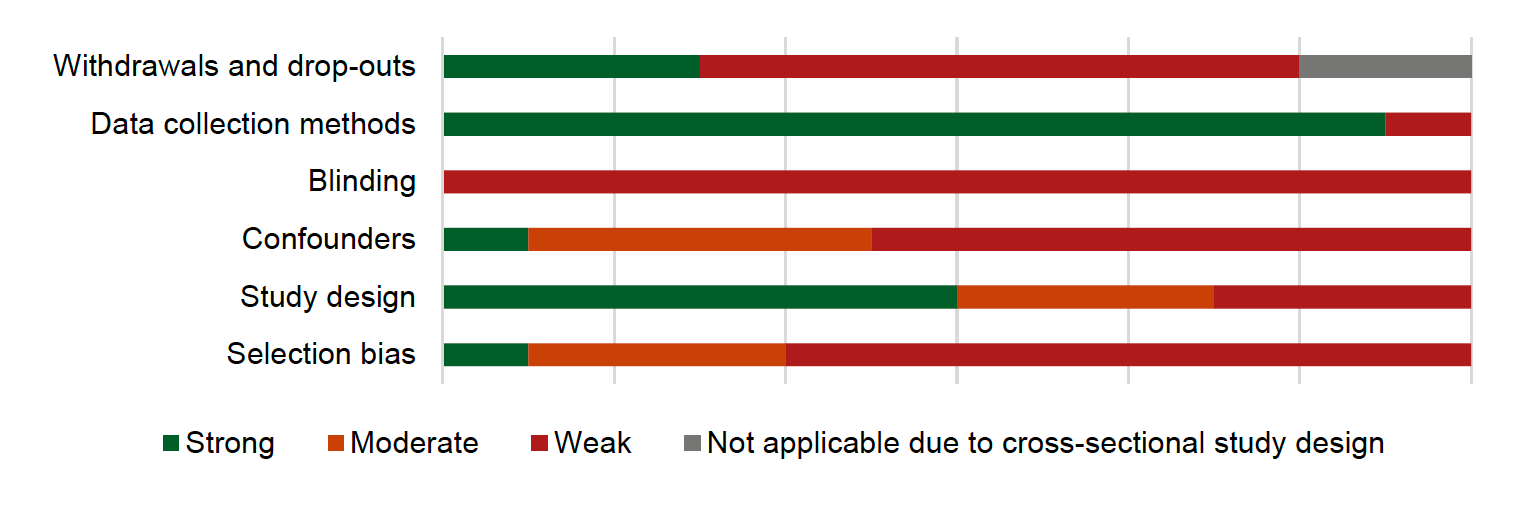
9.1. Nature-based ELC settings
Table 9 presents the results for nature connectedness in eligible studies where these outcomes were reported in more than one study. Six studies assessed nature relatedness (or biophilia) and five studies reported higher scores in children who attended nature ELC, of which four studies were significant (43, 45, 77-79). One study showed no difference (80). For environmentally responsible behaviour, two studies showed a negative health impact (43, 45), although differences between children who attended nature-based ELC and traditional ELC were marginal (43, 45). One study also reported higher scores in children who attended nature ELC (78). Finally, in two studies, awareness of environment was higher in children who attended nature ELC compared to traditional settings (58, 78).
There were also improvements in knowledge and skills of nature in children who attended an educational intervention (76) and awareness of the surrounding environment was higher children who attended nature ELC (58).
| Study ID | Study Design | Sample size (E/C) | Favours comparison | Favours nature | |||||
|---|---|---|---|---|---|---|---|---|---|
| Nature Relatedness / biophilia | |||||||||
| Elliot et al (2014)(43) | Controlled before & after | 21 / 22 | DG | ||||||
| Müller et al (2017)(45) | Controlled before & after | 43 / 45 | G | ||||||
| Yilmaz et al (2020)(77) | Uncontrolled before & after | 40 | DG | ||||||
| Barrable et al (2020)(78) | Controlled cross-sectional | 141 / 110 | DG | ||||||
| Giusti et al (2014)(79) | Controlled cross-sectional | 11 / 16 | DG | ||||||
| Rice & Torquati (2013)(80) | Controlled cross-sectional | 68 / 46 | / | / | |||||
| Environmentally responsible behaviour | |||||||||
| Elliot et al (2014)(43) | Controlled before & after | 21 / 22 | O | ||||||
| Müller et al (2017)(45) | Controlled before & after | 43 / 45 | O | ||||||
| Barrable et al (2020)(78) | Controlled cross-sectional | 141 / 110 | DG | ||||||
| Awareness of nature / environment | |||||||||
| Agostini et al (2018)(58) | Controlled before & after | 41 / 52 | G | ||||||
| Barrable et al (2020)(78) | Controlled cross-sectional | 141 / 110 | G | ||||||
Abbreviations: E= experimental; C= comparison; N= number; ELC= Early learning and childcare.
One colour block = one study.
■ (dark green – DG) = favours nature and statistical significance (p<.05); ■ (green – G) = favours nature; ■ (orange – O) = favours comparison; ■ (grey – //) = favours neither nature or control, or statistics not presented.
Controlled before & after studies – difference between experimental and control group at follow-up (unless stated). Uncontrolled before & after studies – change since baseline (unless stated). Controlled cross sectional – difference between experimental and control (unless stated). Cross-sectional – positive, negative or no association.
10. Play behaviour
A total of ten studies included an outcome related to children's play behaviour, of which three studies were controlled before and after (34, 58, 67, 68), one was uncontrolled before and after (42), three were controlled cross-sectional (81-83) and three were cross-sectional (84-86). The quality across the ten studies reporting on play behaviour outcomes is shown in Figure 14.
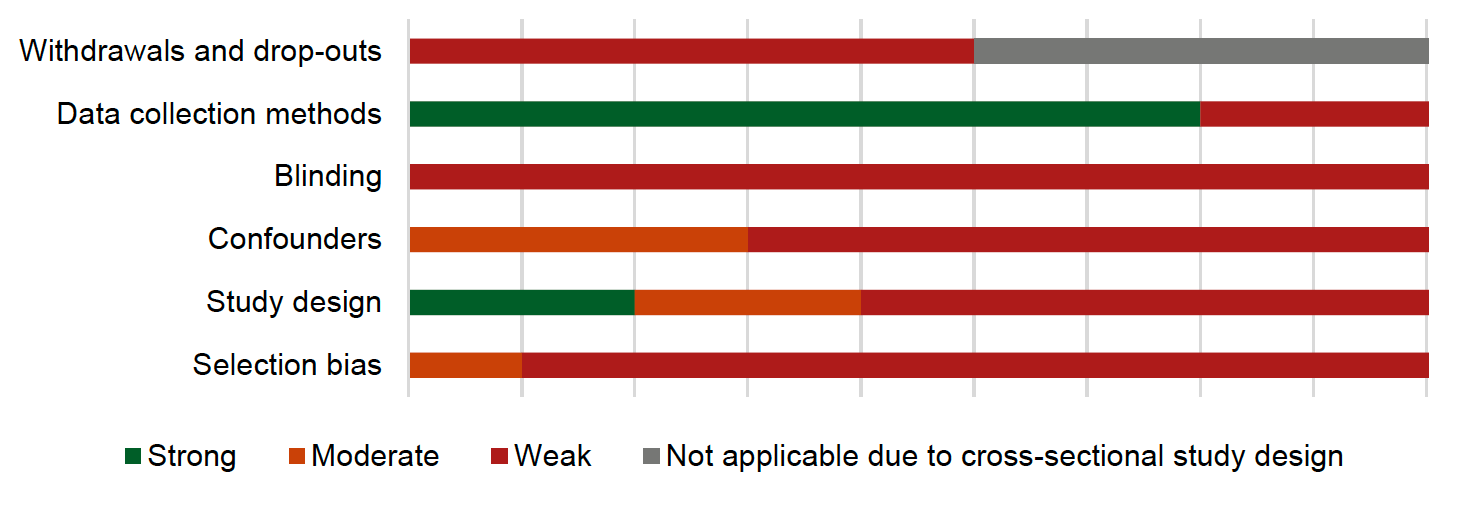
10.1. Nature-based ELC settings
Table 10 presents the results for play behaviour in eligible studies where these outcomes were reported in more than one study. Three studies assessed play interaction, two demonstrated significantly higher play interactions in children who attended nature ELC and one showed less (34, 67, 68, 81). Findings for play disconnection and disruption were mixed (34, 67, 68).
Overall play development and pretend play was higher in nature ELC compared to traditional settings (34, 58).
| Study ID | Study Design | Sample size (E/C) | Favours comparison | Favours nature | |||||
|---|---|---|---|---|---|---|---|---|---|
| Play interaction | |||||||||
| Cordiano et al (2019)(34) | Controlled before & after | 12 / 14 | O | ||||||
| Burgess & Ernst (2020)(67, 68) | Controlled before & after | 84 / 24 | DG | ||||||
| Robertson et al (2020)(81) | Controlled cross-sectional | 15 / 15 | DG | ||||||
| Play disruption | |||||||||
| Cordiano et al (2019)(34) | Controlled before & after | 12 / 14 | R | ||||||
| Burgess & Ernst (2020)(67, 68) | Controlled before & after | 84 / 24 | DG | ||||||
| Play disconnection | |||||||||
| Cordiano et al (2019)(34) | Controlled before & after | 12 / 14 | R | ||||||
| Burgess & Ernst (2020)(67, 68) | Controlled before & after | 84 / 24 | DG | ||||||
Abbreviations: E= experimental; C= comparison; N= number; ELC= Early learning and childcare.
One colour block = one study.
■ (dark green – DG) = favours nature and statistical significance (p<.05); ■ (green – G) = favours nature; ■ (orange – O) = favours comparison; ■ (red – R) = favours comparison and statistical significance (p<.05).
Controlled before & after studies – difference between experimental and control group at follow-up (unless stated). Uncontrolled before & after studies – change since baseline (unless stated). Controlled cross sectional – difference between experimental and control (unless stated). Cross-sectional – positive, negative or no association.
10.2. Naturalised playgrounds
Five studies with naturalised playgrounds included outcomes related to children's play behaviours. One study was an intervention where children were measured prior to their playgrounds being modified to include more nature and again once the renovations were completed (42). The other studies compared play in natural versus traditional playgrounds (82-85). The intervention study found significant improvements in playing with natural elements from baseline to follow-up (42). There was also more risky play, solitary play and more prosocial and less antisocial behaviours observed in their play (42). There was also evidence across studies to indicate that children engaged in more creative and imaginative play. Dramatic play was significantly higher in natural playgrounds compared to manufactured ones (82). In another study, in the natural playground children engaged in longer episodes of sociodramatic play episodes compared to children from the traditional playground and were more likely to engage in object substitutions, explicit metacommunication (nonverbal cues such as tone of voice, body language etc.) imaginative transformations (85). Functional and constructive play was also higher, but creative and imaginative play was low across playgrounds with natural areas and those with no natural areas (84). However, another study demonstrated that functional and imaginative play tended to be higher in traditional playground compared to natural ones (83).
10.3. Types of natural elements
One study looked at cognitive play (functional, constructive, exploratory, dramatic, games with rules) across natural, mixed and manufactured zones in playgrounds. Compared to the mixed and traditional zones, the natural area afforded greater dramatic, exploratory and constructive play (86).
Summary of social, emotional and environmental development
In summary, across a small number of studies, findings were inconsistent for social skills, social and emotional development, attachment, initiative and behavioural problems. Evidence for the environmental domain indicated positive associations with nature relatedness. Findings for awareness of nature and environmentally responsible behaviour were inconsistent. There was also an indication that play interaction was higher in children who attended nature ELC compared to traditional ELC. Findings for play disruption and disconnection were inconsistent.
Main findings – Qualitative research studies
There were ten studies included in the thematic analysis (see Appendix C and E for characteristics and findings of included studies), of which, six studies involved nature-based ELC, three studies were naturalised playgrounds and one study included natural elements. A combination of direct observation and interviews (predominately with educators) were the most commonly used methods to collect data.
Findings from the thematic analysis indicated four main themes (presented in Figure 15):
1. Natural ELC settings provide more affordances compared to traditional ELC settings
2. Natural and traditional ELC settings provide similar affordances
3. Children's preferences of setting types
4. Restorative effect of nature
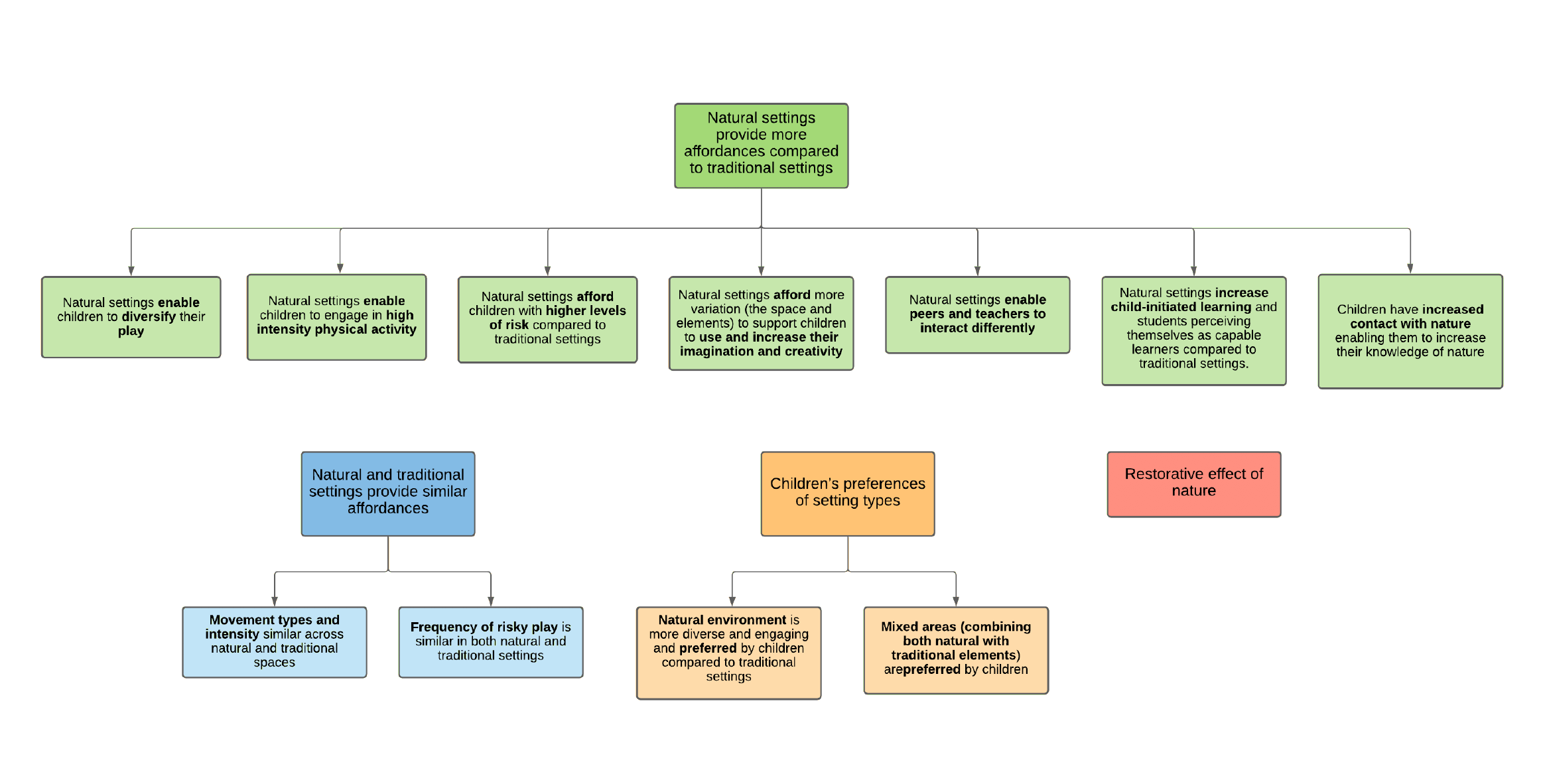
Theme 1: Natural ELC settings provide more affordances compared to traditional ELC settings
This theme included a number of sub-themes all relating to the different affordances that nature provides compared to traditional settings, including: diversifying play; high intensity physical activity; risk; increased imagination and creativity; peer and teacher interactions; child-initiated learning and perception of learning, and increase their knowledge of nature.
The majority of studies (n=7) indicated that nature afforded children with the opportunity to engage in a range of play types (32, 33, 86-90). This is important for movement and physical activity but also supports social interaction and creativity. Related to diversifying play, two studies reported that nature enables children to engage in high intensity physical activity (89, 91). Similarly, two studies suggested that nature setting afford higher levels of risk (90, 92), but not necessarily higher frequency of risky play (see Theme 2).
"High physical-motor levels are created, the children jump down and run back up. They talk, shout and laugh. Three of the girls jump together and try to land in differing ways. They hold hands and try to jump together from the small knoll. There is laughter. They are eager and enduring. The small knoll has many opportunities for variation, in height and width, which invite challenges suitable for each child's resources. The children have visual, verbal and physical contact with each other. The top of the knoll provides an overview. Some find it scary the first time they try, but together they challenge each other, supporting and encouraging each other. The children decide how much they will participate and how they jump, and how they wish to solve the challenges offered by the knoll" (91).
"I like playing in the fallen logs and trees on the playground; it is so much fun, but a bit scary too! I like the big pile of sticks and logs that we made – it is for another fort that is going to be really high off the ground." (92).
Findings from this theme also indicated the importance of the natural environment for increasing imagination and creativity (86, 88, 92), increasing contact with nature (33, 88, 89) and enabling children to interact with peers and teachers differently (33, 88, 91, 92). Another theme noted that natural settings increase child-initiated learning and student perceiving them as capable learners (33, 86, 93).
"[CogG] has poor concentration, sees herself as the baby, finds it difficult to sit and listen to story. She is extremely lacking in confidence … shy … she won't look at you indoors. With child-led learning she is totally engrossed and remains on task. Outside is the best learning environment for her … she remains on task. When outside she will come over and say 'I like this' and 'I like doing that', 'this is my favourite place." (93)
Theme 2: Natural and traditional settings provide similar affordances
This theme included two sub-themes a) movement types and intensity are similar across natural and traditional spaces and b) frequency of risky play is similar in both natural and traditional settings. This theme indicated that two related outcomes: physical activity and risky play are similar no matter the playground type (nature or traditional). Sandseter (2009) noted that children will always seek risk no matter the playground type, but natural areas provide the opportunity for greater risk (see Theme 1) (90). Similarly, in another study movement types and intensity did not vary in natural playgrounds compared to traditional playgrounds (32). However, this was found it one study only. Theme 1 indicated that natural settings enable children to engage in high intensity physical activity and to diversify their play.
Theme 3: Children's preferences of setting types
This theme included two sub-themes a) natural environment is more diverse and engaging and preferred by children compared to traditional settings and b) mixed areas (combining both natural with traditional elements) are preferred by children.
Two studies indicated that children preferred the natural environment compared to the traditional (91, 92) and one indicated they preferred mixed-areas (86). Based on the three studies, it appears that children at minimum prefer their playground somewhat naturalised.
"I like going outside and playing! I like playing with my friends, Sydney and Megan. We play hide and seek on the playground and hide in the forest in the logs and trees. I like outside [in nature] because it's so fun and I really like to play. Sometimes I play with my sister too; I like all the colours outside and all the space." (92)
Theme 4: Restorative effect of nature
Two studies indicated the benefits of the natural environment for having a restorative effect on children (88). The experiences and exposure to nature enabled children to be energetic and engage in a variety of play types, but it was noted that these experiences supported them to sleep easier and restore their energy levels.
"Now it's become very difficult to finish playing. They would rather continue, and those who need to take a nap, they've had a nice, long time outdoors and nice games so they fall asleep more easily, and it affects their energy in the afternoon. Some children have very long days here. They come in the morning and stay until five o'clock; they seem to be somehow energetic and lively in the yard. This is new for us. The contrast to the previous yard is so great that the effects can be seen here very quickly." (89)
Summary of qualitative evidence
Findings from the qualitative evidence suggests that compared to traditional settings, the natural environment affords many more opportunities for children to be physically active, play and interact with their peers. Natural settings are also important for providing restoration for children. Children also prefer settings which integrate some nature either a full naturalised playground or a mixed area. A small number of studies indicated that movement and risky play were similar no matter the setting type.
Logic model
Figure 16 presents a logic model of the combined quantitative and qualitative evidence. The purpose of this logic model is to present what is required for a nature-based ELC to function (the inputs), what are the direct environmental and child level outputs and what the possible short and intermediate term outcomes might be for children.
We could only draw conclusions on short term outcomes because studies did not assess the longer term impacts of nature-based ELC. We propose what the longer-term outcomes and impact (grey box) might be based on other evidence (detailed in the discussion). Based on the evidence we could not draw specific conclusions on what the possible causal pathways might be, but this logic model can act as a hypothesis of what the benefits are for children and what has caused these benefits.
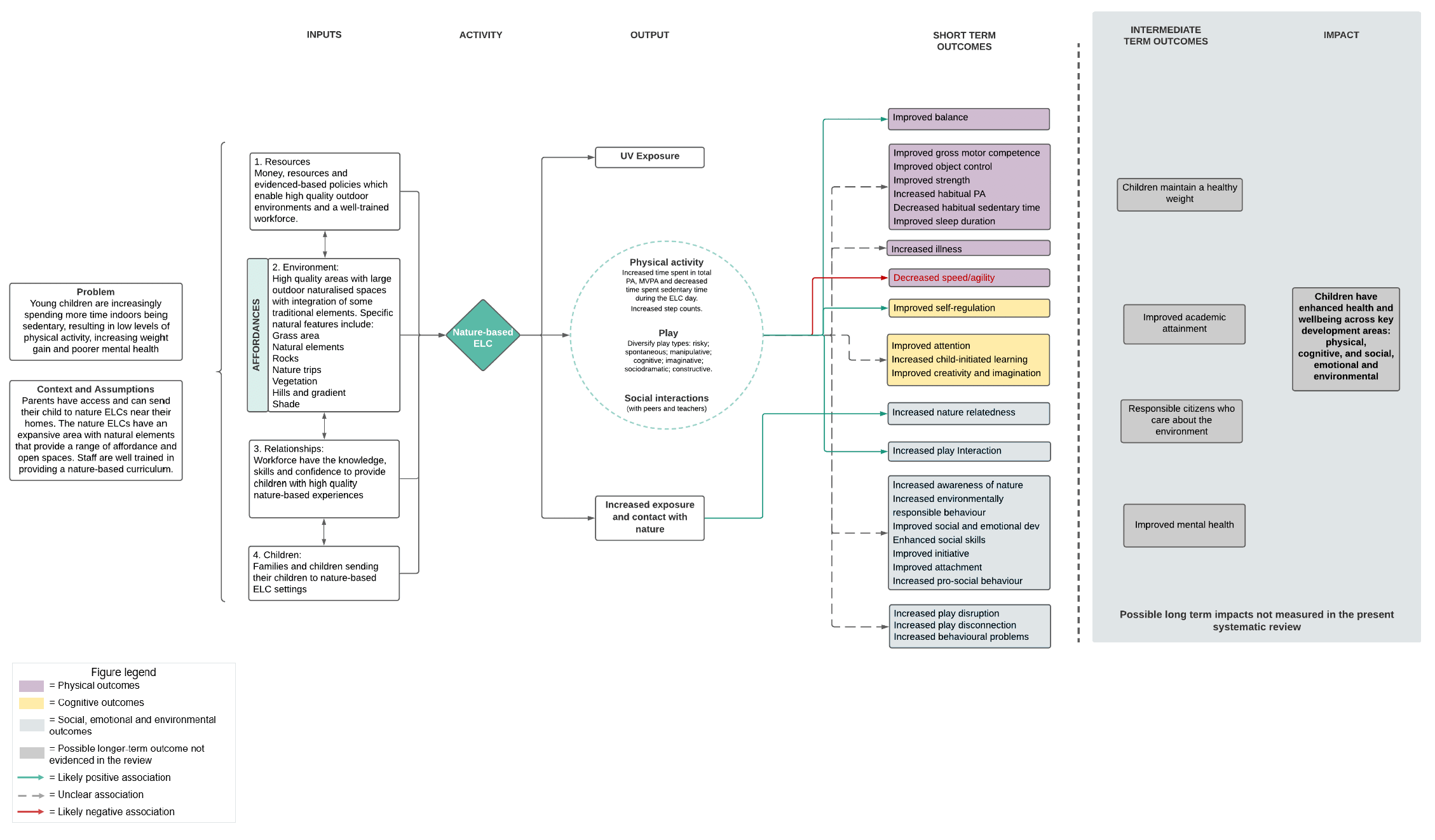
Contact
Email: socialresearch@gov.scot
There is a problem
Thanks for your feedback